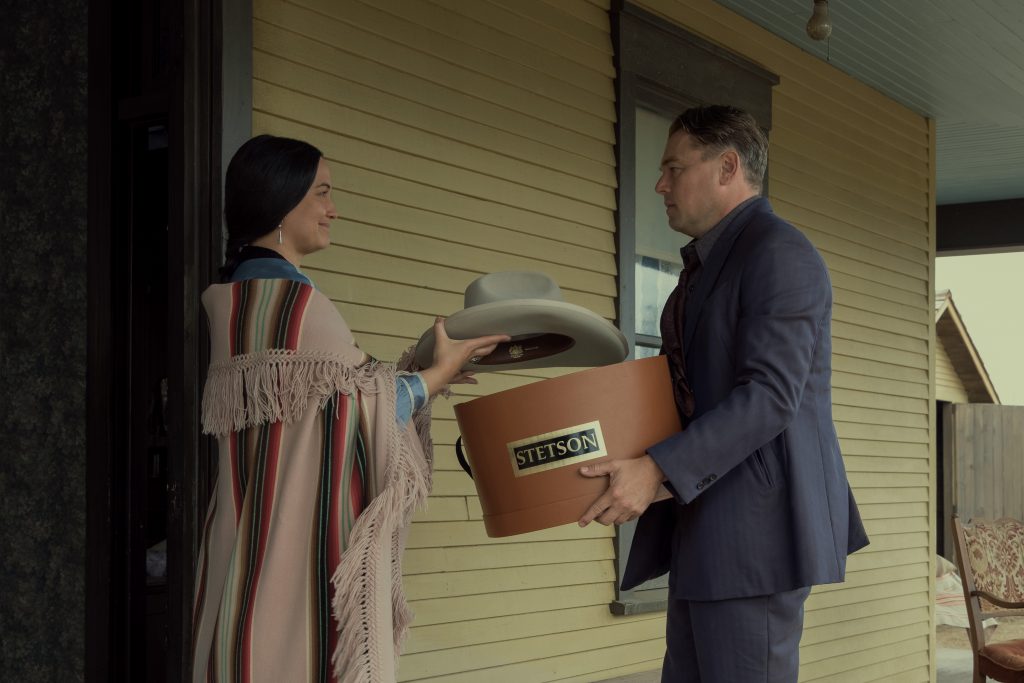
It’s almost as if costume designer Jacqueline West created her last name as an homage to her love of Hollywood westerns and affinity for the indigenous tribes of the American West and what they wore. A self-described hippie, she gravitated to the fringe and headbands that accented the Native American women’s clothing in “dusty westerns” she would watch with her executive father, bonding with him after being away from home on long business trips. West identified with their heroism and their spirituality, calling them her heroes and not the cowboys, whom she considered “the bad guys.”
With this early childhood reference to guide her, West embraced Killers of the Flower Moon, an epic western crime saga. It was a tailor-made project for her, not to mention reuniting with Leonardo DiCaprio, whom she dressed in bear fur for The Revenant, this time as a 1920s cabbie Ernest Burkhart, who marries an Osage Nation woman of means, Mollie Kyle (Lily Gladstone).
Based on David Grann’s best-selling book, the film tracks the true story of the murders of members of the Osage Nation, who became wealthy landowners after discovering oil under their land, and the unspeakable evil at the hands of white men who live among them. Jacqueline West, whose other impressive credits include The Curious Case of Benjamin Button, The Tree of Life, The Revenant, Dune, Quills, and Henry & June, relied heavily on her art history background to flesh out the wardrobe for Killers of the Flower Moon, from the custom-made blankets of the Osage women to the authentic attire of the Osage men.
Below The Line spoke with Jacqueline West via Zoom video, where she was excited to talk about the evolution of her costume designs for the Martin Scorsese film.
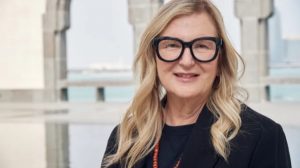
Below The Line: How did you actually become a costume designer, specifically your interest in the indigenous tribes of the American West?
Jacqueline West: I was a fashion designer before I was a costume designer. When I was a child, my father was obsessed with Westerns, and that was how I could relate to him because he traveled all the time. He was a business executive. He was never home. He was always on an airplane. When he came home, he’d say, “Let’s watch a dusty one.” You know, I always wanted to make a Jackie West western, but this was my favorite. People in westerns were always Native Americans, right? I’m a hippie girl, and that’s what we wore—you know, fringe and headbands—and that’s what we wanted to be. They were the good guys, and the establishment were the bad guys, right? So those were my heroes.
Later on, after I did The New World, I was offered a Native American scholarship at The Fashion Institute of Design and Merchandising in Los Angeles and started finding young girls, boys, young men, and women that grew up on the reservation but had talent and could maybe get scholarships there. I had the scholarship for a long time, but then we moved. My husband’s mother was full Blackfeet, and when we moved to Deadwood, it’s very close to the Sioux Nation, so I started really spending some time there working with young girls, getting them involved in design and fashion, and they’re all learning their crafts from their grandmothers and their aunts.
I think it’s just been since I was a little girl watching westerns that I’ve been fascinated, and so that’s what started me. My mother was a fashion designer in the late forties and early fifties. She wore only Dior. I grew up instead of the Barbie doll; I had a big mannequin in my bedroom, and I would dress the mannequin in my mother’s discarded old Dior clothing.
BTL: That’s great! How did you turn that interest into a career?
West: I finished at Berkeley, where I was an art history student, and you can’t do much with that! My first husband came home one day, and he said, “I just rented you a store in Berkeley. Everyone wants to know what you’re wearing all the time. I think you should do a clothing store. That’s your background.” I said, “No, it’s not my background; it’s art history,” but he insisted. Then my best friend opened a restaurant right next door, Chez Panisse, where (director) Phil Kaufman was eating all the time. He said you should be in the film business, and he headhunted me to do Henry and June.
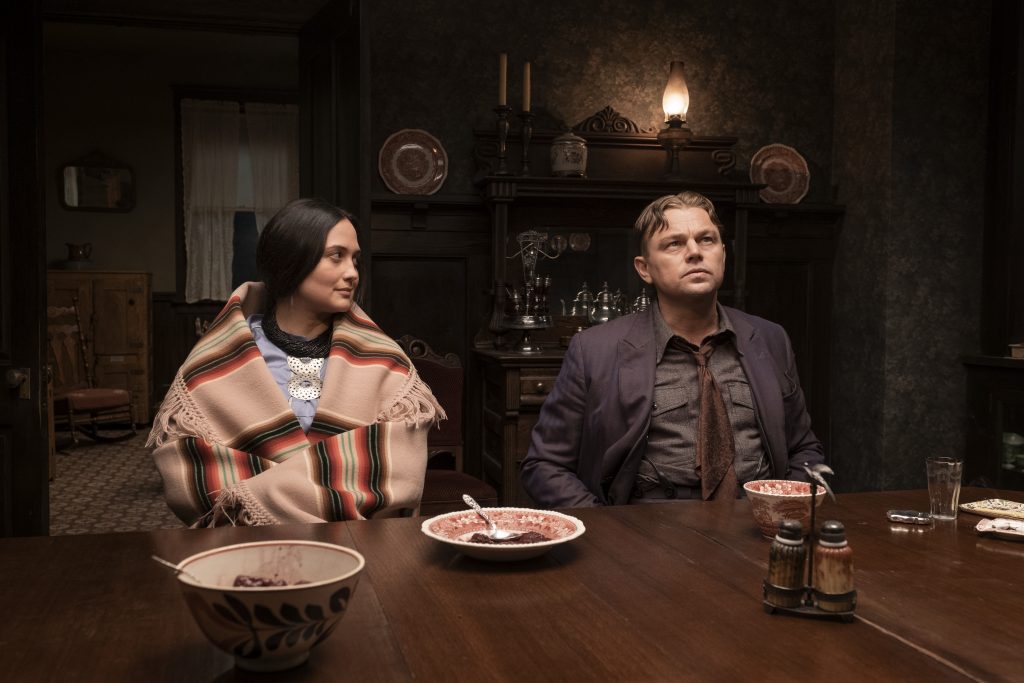
BTL: That was your first ever costuming job? Were you nervous?
West: I said I’m a fairly modern Millie. I’m a fashion person. I had my own department at Barney’s and Fred Siegel. And he said, “You run a huge company; you can do the film business.”
BTL: We’ve got so much to unpack for this film so I wanted to begin with getting the authenticity just right for the Osage women and what they wore. Where did your research begin?
West: That’s a good question. It all started once Marty hired me and gave me the final go-ahead. I kind of had a strong sensibility about what he wanted, and he wanted it to be totally authentic. My husband was a fashion photographer for Vogue back in the day, and I have nothing but photographic books. I love photographs more than anything, and I am an art historian. I just started amassing every single photograph I could get of the Osage.
In fact, we have a house in Deadwood, South Dakota, and there’s the Carnegie Museum. It’s also near Prairie’s Edge in Rapid City, which has an incredible Native American section and a museum-quality library section where I could go and buy books. I started just diving in, and my husband helped me tremendously. We looked at so many photographs, and I got a team in L.A. going, and they were sending me massive photographs from this period for all the townspeople and all the businessmen. I had these 10-foot-tall boards, 5 feet across, and we must have had 100 of them.
BTL: Once you selected these photographs, what was the next step?
West: I brought about 2,000 photographs to Oklahoma. On top of that, Marianne Bauer, who’s Marty’s researcher and one of his producers, was sending me incredible photographs that she was amassing—anything that had to do with wardrobe. I would put them on boards by who they were, like barbers, shopkeepers, cowboys, ranchers, Osage, road men—just studio shots.
BTL: Didn’t you also have access to home movies of the Osage?
West: The Osage were very interesting in that they could afford to make home movies when probably no one else in the world could but the British Royal family. It was like $1,800 a minute, and they could afford them. They documented their lives from this period before they were murdered for their money, but when the wealth started rolling in, they flew airplanes. They did archery. They played golf. They traveled all over the world. They bought their clothes in Paris and New York. They sent their kids to Ivy League schools. They vacationed at world-class spas, and they took tourist shots and documented themselves.
BTL: Let’s tabout the authentic costume designs for the sisters, Mollie Burkhart (Lily Gladstone), Anna Brown (Cara Jade Myers) Reta Smith (Janae Collins) Minnie Smith, Jillian Dion and their mother, Lizzie (Tantoo Cardinal). What did you want to communicate with them?
West: For the sisters, I made boards because I thought that I could create a microcosm with them. Anna never wore traditional clothing. She was the modern, the one that’s murdered. Mollie was always the top button. She was traditional and stayed traditional with the exception of maybe an expensive handbag or some fabulous French shoes of the period, and then the other sisters were combinations thereof. Mollie wore moccasins unless she was going into town to talk to a guardian or something where she wanted to be a little bit more powerful.
Minnie and Rita were part modern, part she’s the one who really wants the approval of Lizzie, her mother. Anna was a modern, and I based her on Natacha Rambova, Rudolf Valentino’s wife, who did buy all her clothes in Paris and had incredible style, but being Russian, she was like something out of the Russian ballet with the headset braids and stuff. I thought, “Oh, that’s great,” and Anna’s coloring was so much like Rambova, I thought that’s a great reference. I showed it to Marty, and he loved it. Her clothes were sexy and provocative for that era, and I thought they were perfect for her.
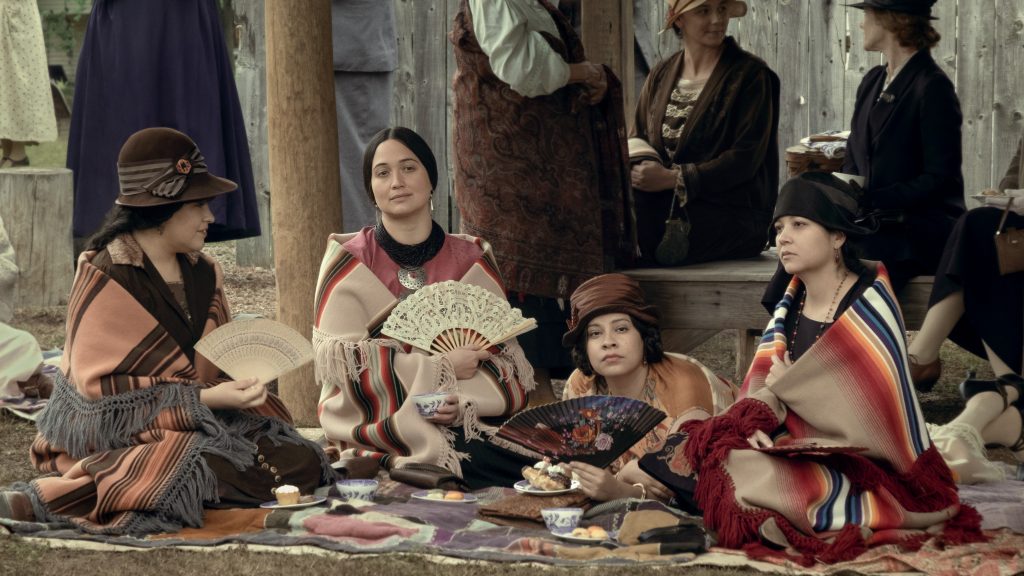
BTL: I understand the blankets the Osage women wore were also very autentic.
West: We enlisted Pendleton Blankets to recreate all the blankets. The actual Osage community donated their blankets to those in the movie. They had ones in their cedar chest that maybe their grandmothers had or grandfathers had from this era. They would bring them when they were going to be on camera and see if I was okay with them wearing it.
They were modern and traditional. The blankets were always worn for anything ceremonial, even over their modern clothing. Mollie wants to hang on to tradition. She knows how powerful her tradition is, and she wears that blanket almost like armor when she talks to the guardian, like a power suit for the ’80s, when women were coming into their own in business.
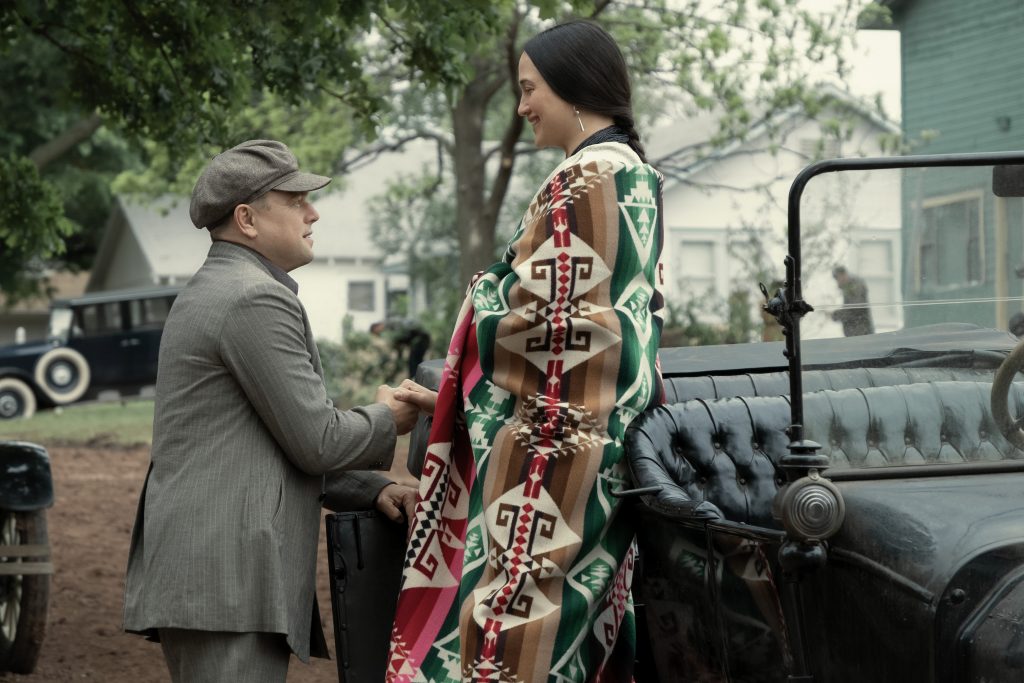
BTL: As for the men, I understand that there’s a photo of a cabbie that looks exactly like Leonardo DiCaprio. Where did you find this photo?
West: I flipped out because it looked like Leo sitting in the car, and I showed it to Leo early on, and he just loved it. I don’t even remember where I found that photo. I think I was looking at Osage people from that period in Osage County, non-Osage people who worked for the Osage, and there it was. When I found it, I thought, “Okay, that’s the key to Leo’s character from where he starts and then to where he goes.” That’s when he meets Mollie (as a cabbie), and it’s life-changing.
BTL: After he marries Mollie, Leo’s clothes become much more refined. Who did you model his look after?
West: There’s a famous actor named Tom Mix who lived in Pawhuska, and he had all his clothes tailor-made there. So my friend Diana Foster owns United American Costume. Her father was Luster Bayless, who dressed John Wayne his entire career. She had all these patterns from the 1920s. She had a pattern that was called the Tom Mix suit that I made for Leo.
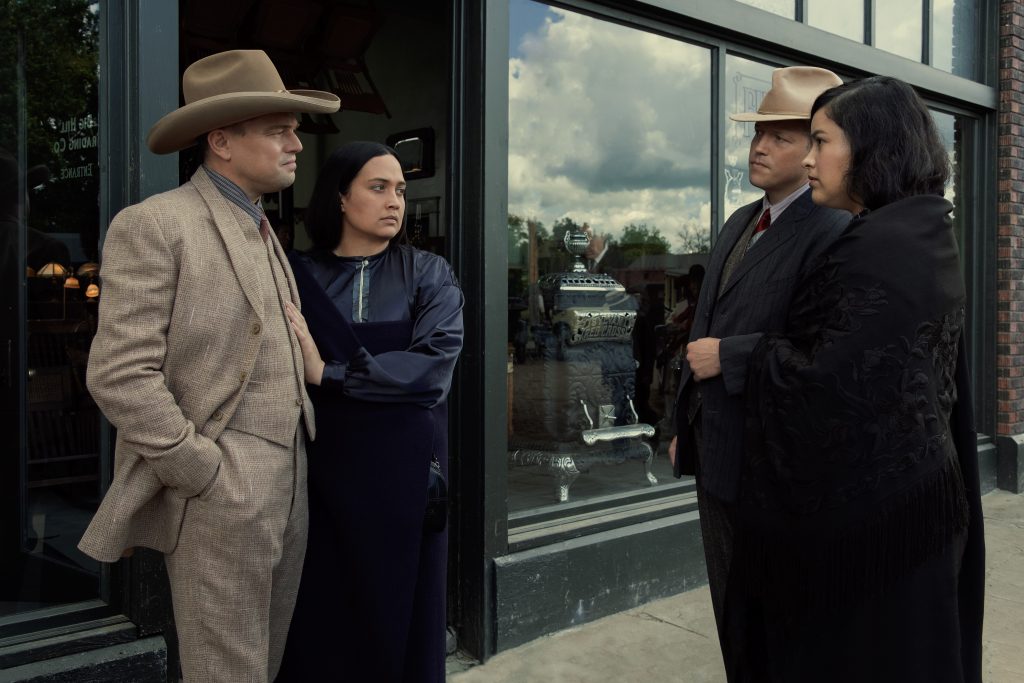
BTL: What about the design of Leo’s boots and his hat? Where did those come from?
West: I live in South Dakota, which is cowboy country. There’s a bootmaker in Belle Fourche, which is a famous cowboy town that few people know about. The cattlemen and all of the cattle ranchers from Texas, Kansas, and everywhere drove their cattle to Belle Fourche to be put on trains. That was the end of the cattle drive, and they used that in the movie, where the cowboys went to Belle Fourche and shipped all their cattle to Chicago for the big processing companies. Belle Fourche has been historically one of the famous cattle towns in the old West, and so there’s these age-old companies.
One of them, my friend George Wilson, who I’ve gotten to be friends with through the years, bought my cowboy boots from him and stuff; he makes cowboy boots for all the modern-day famous rodeo guys. They all go to him. His father and grandfather made John Wayne’s boots through his career. His grandfather made boots for Tom Mix. That’s kind of where I got the clue to use Tom Mix, as his pictures are in his Belle Fourche store called Cowboys Too. So he reproduced the boots that Tom Mix had from my research and made all of Leo’s boots, his high boots, and his plain boots. He made all the boots for the Osage.
Then across the street is a famous old hat maker from the 1920s called the Weather Hat Company. The man who owns it, Jack, is a good friend of my husband’s, and he had hat blocks from the twenties in his showroom. I have a picture of him making Leo’s hat that his wife took when he was actually making and molding his hat. He also made Robert De Niro‘s hats. He also made the open road, which was the rancher’s hat of the period. So he made all of Leo’s Stetsons and did a lot of my background.
BTL: How did Cowboys Too help out with the Osage men?
West: I took photos of the Osage men who weren’t traditional and had a very Western look, but they didn’t wear suits. They didn’t want to be like the bad guys, the guardians, or the bankers. They had a very Western look that they adopted, and they had a Spanish heel boot that went very high up the leg, almost right to the knee. And so he made hundreds of pairs of those for me at his factory. He designed them and made that boot just right off of the Osage research.
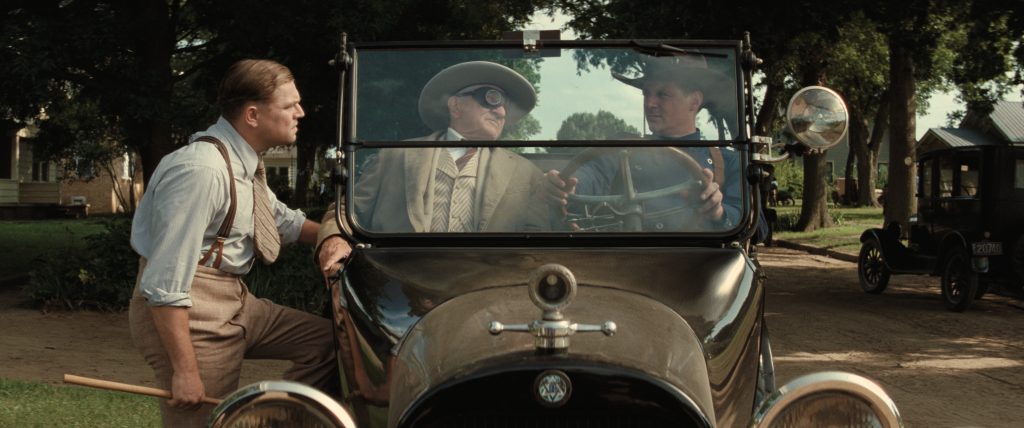
BTL: What other old time movie stars from westerns did you model the cowboy attire after?
West: I remember after Marty hired me, my husband found a wonderful movie called The Winning of Barbara Worth by Henry King that was made in 1926 and shot in 1925, which is perfect for our movie. It was with Gary Cooper, Vilma Bankey, and Ronald Coleman. Because of the characters in the movie, I really based De Niro’s character on Ronald Coleman from that movie, with the goggles and the open road hat. I based a lot of Leo’s more cowboy look, where he’s relating more to his uncle, and his more cowboy wardrobe, on Gary Cooper in that movie with the buckle-back jeans and the boots and everything.
I got on Zoom with Marty. It was COVID, so it was all on Zoom until I got to set in Oklahoma. I happened to mention that movie to Marty, who’s an incredible film historian, as we all know, and he said, “I love that movie, Jacqueline. I love that movie.” So that became a centerpiece. Then my husband found another movie because we watch old films together called Blood on the Moon with Robert Mitchum. It’s from the ’50s. I love the cowboys in it. I got obsessed by the look, and I actually made Robert Mitchum’s coat for Leo, but I had to backdate it all in shapes from the ’50s to the ’20s. That too was one of Marty’s favorite westerns from when he was a kid; he was just obsessed by that western.
BTL: How much feedback did you get from Marty, or did he leave you to work on your own?
West: Because I’d never worked with him before, he needed to have a degree of trust in me. I went about once a week to his house in Oklahoma (where we shot) and showed him where I was on each character and what direction I was heading. I made these big art folders for each character and just started taking all my research that pertained to that character or could pertain to that character, showing Marty before I made it where I was going to go with that character. Of all the directors I’ve ever worked with, he really knows clothes. He’s a connoisseur. He’s Italian, so he knows the good cut of a suit and the great shoes; you know, it’s part of his DNA. My mother was Italian and a fashion designer, so we had that level that we could relate to. We both know how to talk about clothes.
BTL: Julia O’Keefe was the Osage fashion consultant. How was that collaboration?
West: Oh, that was really interesting because I’ve never worked with a consultant before. I mean, there’ve been consultants on movies, like we had a trapper consultant on The Revenant, but I’ve never had a consultant attached to my department. And one day, one of the producers said the Osage Nation would love to have somebody watching over me, making sure I got it right. And I said, “Sure, I love authenticity, and I would love that.”
Chief Standing Bear sent me Julia, who has incredible credentials, both in native crafts, and she knows all the artists and all the artisans in Oklahoma in Osage County that did all the specific things I needed done. I had my own work room, but I could then get samples. We staged a trunk show because it was COVID, with people just driving through our warehouse parking lot and showing me things that I could photograph or borrow from their ancestors from this period. She helped arrange all that through The Osage News.
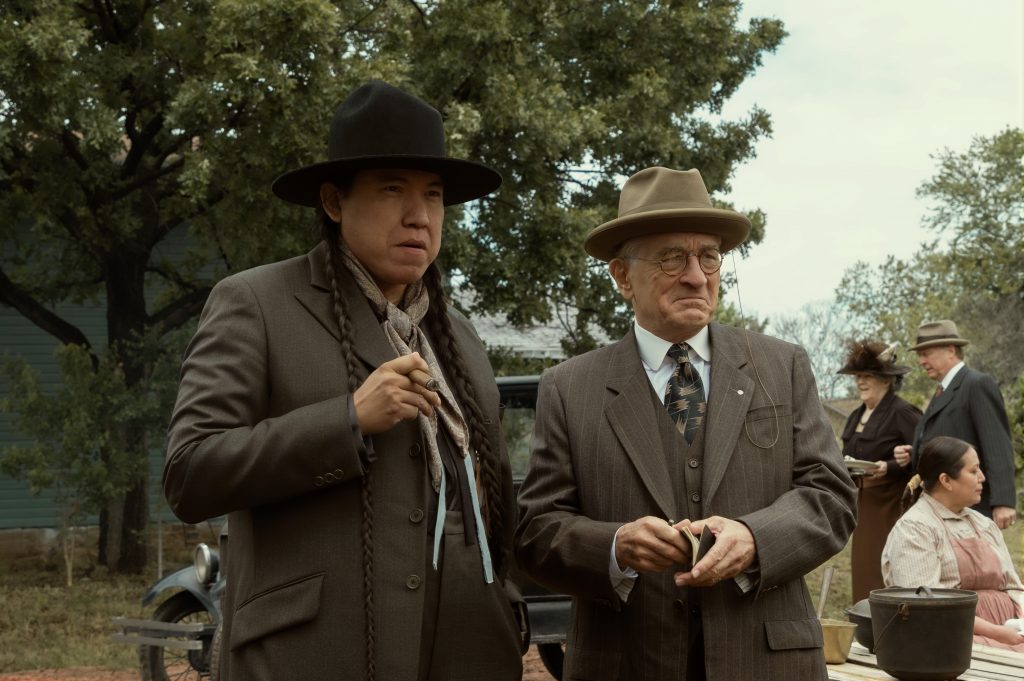
BTL: What are some of your personal connections to tribesmen that you carried with you in this film?
West: When I did The New World, I got to be friends with Chief Two Eagles Green of the Patawomeck. He’s a direct descendant of Pocahontas. He named me White Deer Woman. It has different connotations depending on your history. To this day, we’re friends, and he took me to his house in Virginia and gave me tons of stuff (for this film). He gave me a bead that was 800 years old from the Patawomeck cemetery to wear. He said if I wore that the entire movie, I would never get anything wrong. I wore it all through this movie.
It’s a clay bead, but they would wrap it around straw and then fire it in a kiln and then run a piece of leather through it, and I wore it the entire movie. On The New World, I had the most vivid dreams that I’ve ever had about how everyone should be dressed because there were no photographs back then. I had a few dreams about this movie, too, and I think it’s Chief Green’s bead, but having Julia was better than a bead!
BTL: After your time on Killers of the Flower Moon, what was your biggest take away from the experience?
West: What I took from this film that was most valuable was the friendships I made among the Osage, because Native Americans do have a different way of looking at the world. I mean, in 150 years, we’ve paved over all of America. There’s a place in Wyoming called Ten Sleep, and it’s where all of the tribes left to go to their various areas. All the nations would meet there, and they would live there often for months and months and months.
Even on the Sioux reserve or when you’re crossing the prairie, the only thing left are these kinds of petrified teepee circles. And all we’ve left is cement. They spent 11,000 years developing a philosophy that we all could learn from about nature, the environment, and how humans should treat each other. They’ve been treated so unfairly. So getting to be friends and be trusted by the Osage was the biggest thing I could take away.
Killers of the Flower Moon is now playing in theaters.





